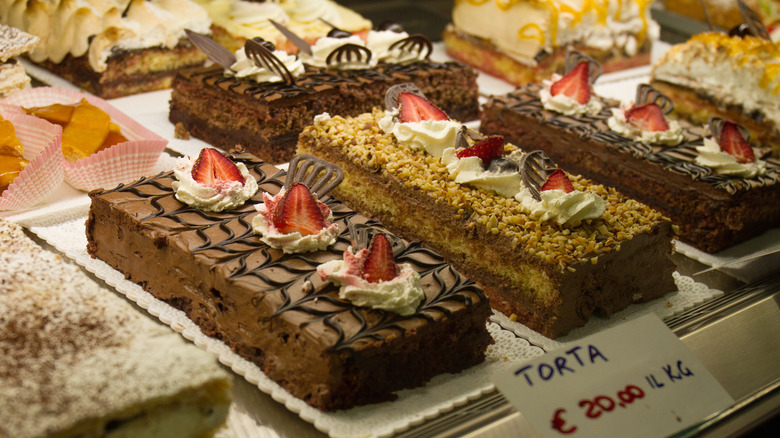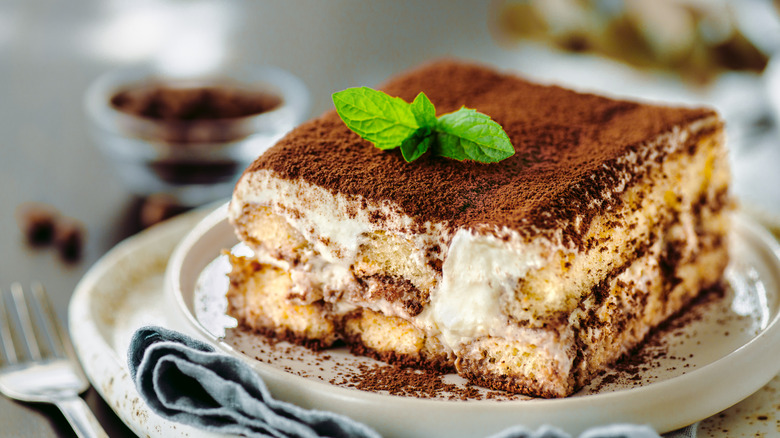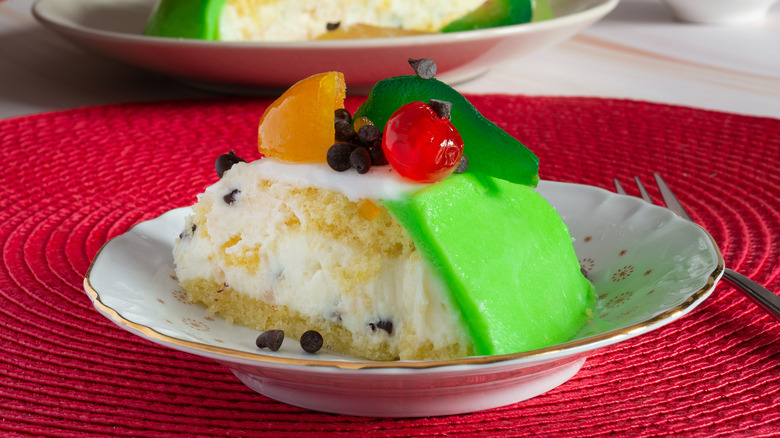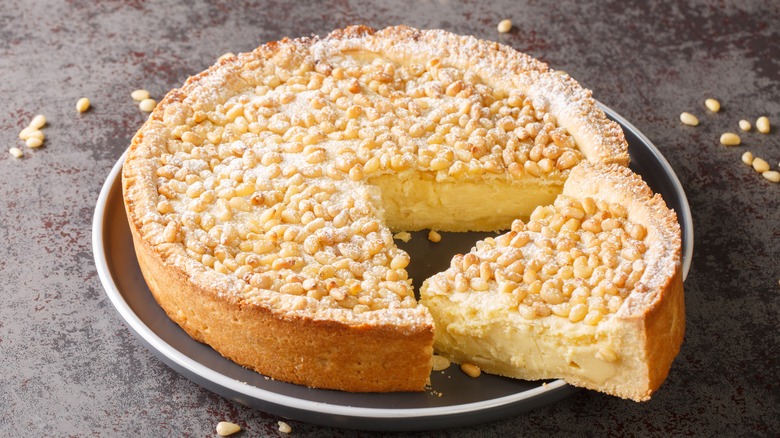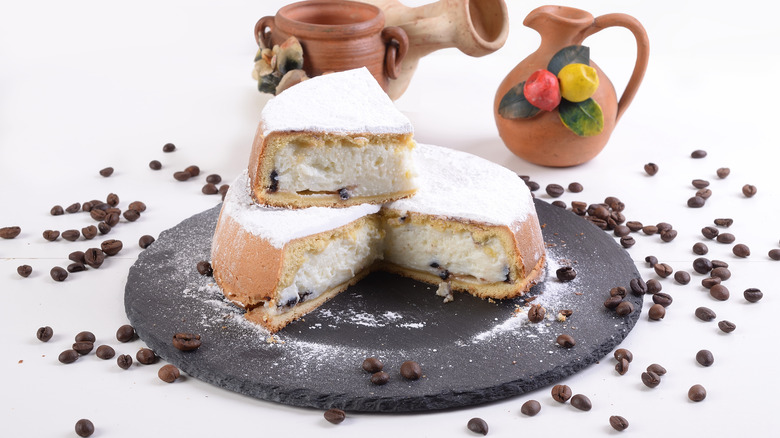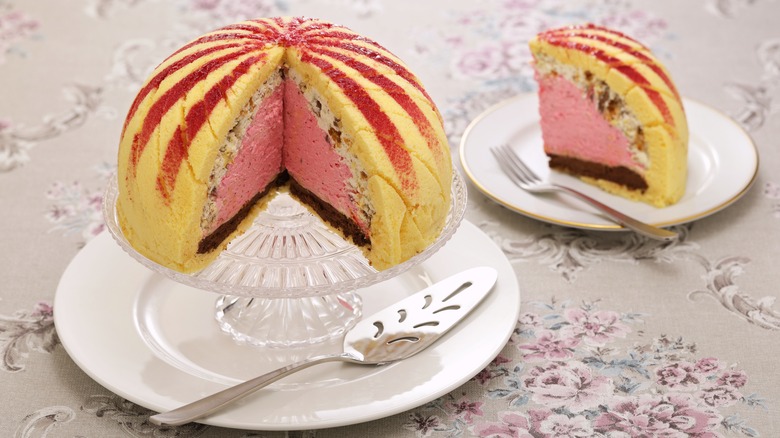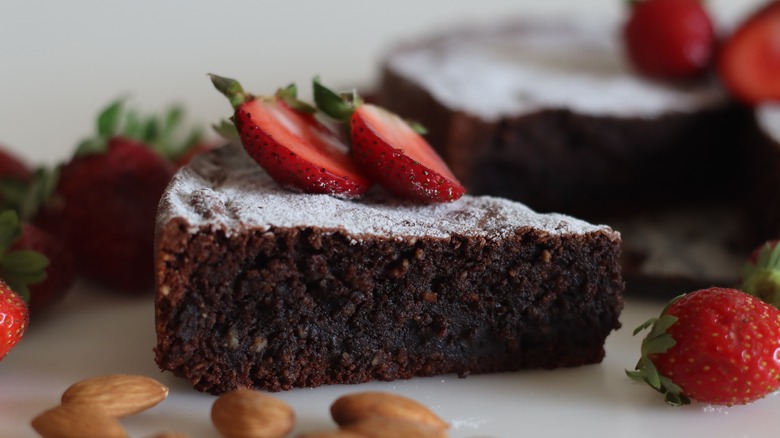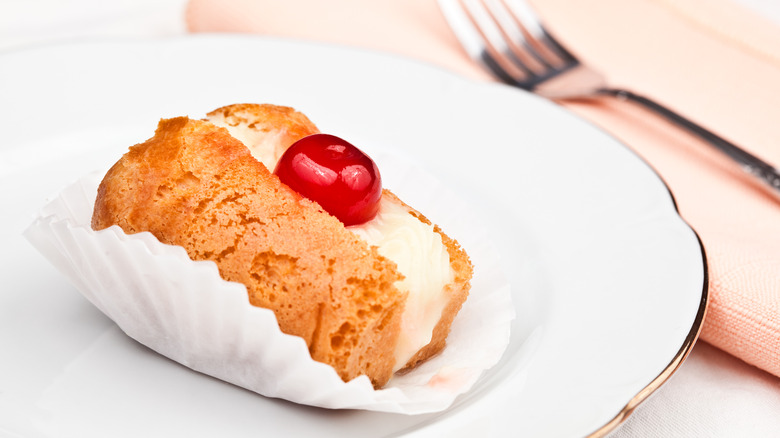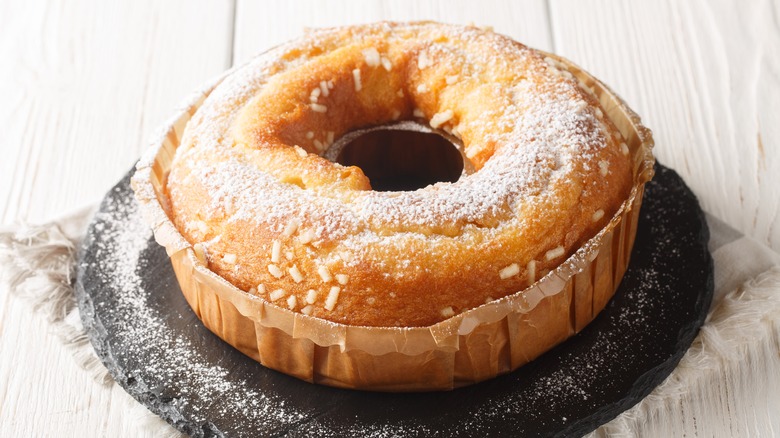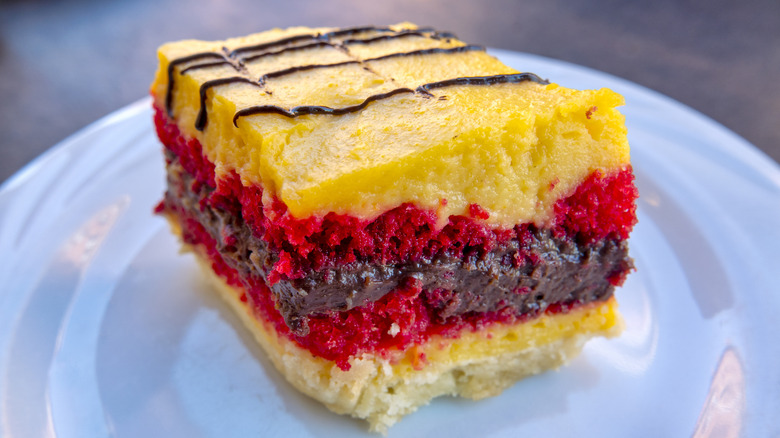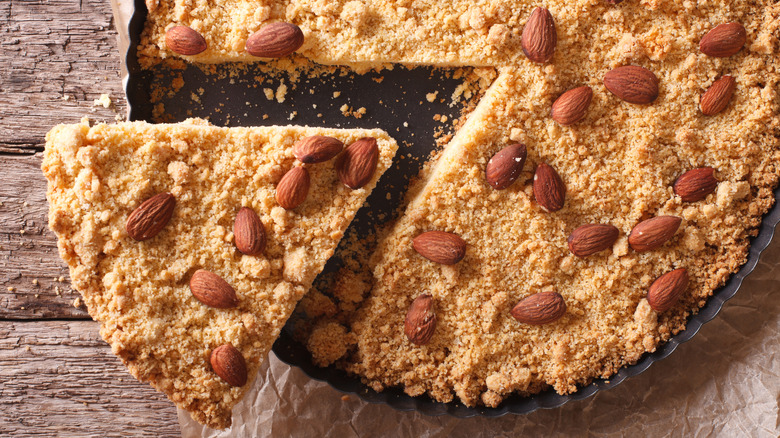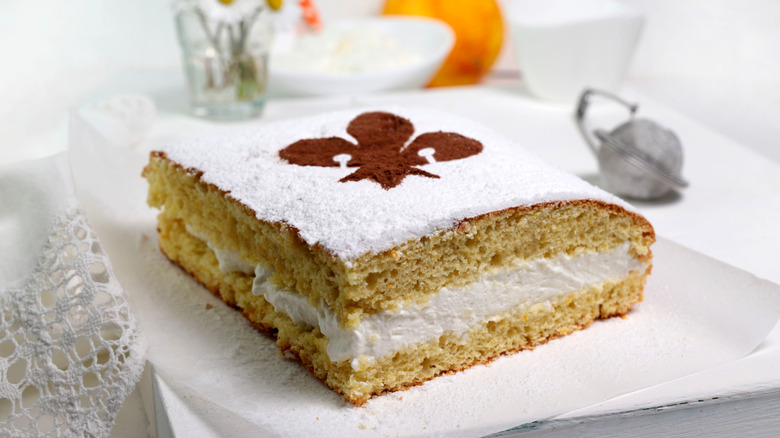12 Delicious Italian Cakes You Need To Try At Least Once
They say that "Italians do it better." And that's undoubtedly true when it comes to wine, classic architecture, and perhaps even more than all those other areas combined, food. Who doesn't love an old-school Italian pizza, or a rich, savory cheese-packed lasagna? There's also hearty Tuscan white bean soup, light and tangy Pasta Al Limone, traditional spaghetti and meatballs, and countless other delectable options. Perhaps that's why Italian-style cuisine is among the most popular and widely cooked foods in the world — we just can't get enough!
But while almost everyone can make a laundry-list-sized rundown of their favorite meat and pasta-based Italian dishes, Italian desserts don't always get the respect or recognition they deserve. Sure, you might know cannolis, biscotti, or gelato. But Italy has so much more to offer, especially with sweets. Take just the world of cakes, for example.
In Italy, the breadth and variety of cakes on menus is just as vast and expansive as it is here in the U.S. There are fabulous cream cakes, lemon ricotta cakes, vibrant rainbow cakes, and more. Some are light and zesty. Others are deep and rich, filled with indulgent creams and topped with decadent frostings. It's a virtual wonderland of treats to explore, especially if you are new to the Italian dessert scene.
Ready to learn more? Grab some espresso or cappuccino, and get ready for your mouth to water as we explore our picks for the dozen delicious Italian cakes everyone should try at least once.
1. Tiramisu
Tiramisu ("tee-rah-mee-soo") is perhaps Italy's most famous cake and the dessert that has made the biggest impression here in the States. It's on the menu at many Italian restaurants, but there are still plenty of us out there who have never tried this iconic treat. And if you fall within that camp, you're missing out.
Made from an unbelievably delicious pairing of ladyfinger cookies, mascarpone cheese, eggs, sugar, strong coffee, cocoa powder, and either Marsala wine, amaretto, or coffee liqueur, tiramisu is almost as tasty to look at as it is to eat. The ladyfingers in the cake are soaked in coffee and alcohol, piled high with the mascarpone mixture, topped with a light dusting of cocoa powder, and then chilled to heavenly perfection.
With its rich union of coffee, chocolate, and sugar, tiramisu makes an ideal afternoon snack. Its name literally translates to "pick me up" because of the way it can supercharge lagging energy levels. According to local legend, this ability to "lift" a person's mood may also have been why the cake was created in the first place — it was considered an "aphrodisiac" and served to customers in houses of "ill-repute," so people had the energy to get back home after an evening out. Somehow, with an origin story this scandalous, the cake only seems that much more decadent and satisfying!
2. Cassata Siciliana
Like a cannoli in cake form, Cassata Siciliana ("kah-sah-tah see-chee-lee-AH-nah") combines layers of sponge cake and a creamy filling made with ricotta cheese, sugar, and chocolate chips. (The name of the cake loosely translates as a "cheese basin.") Once assembled, the cake is topped with a lush layer of vibrantly-colored marzipan or icing and decorated with candied citrus-flavored fruits and other festive garnishes. While many versions of Cassata Siciliana have a basic vanilla flavor, the sponge cake or filling can also sometimes be seasoned with additional cinnamon or citrus zest.
Cassata Siciliana is a rich and indulgent cake. It oozes sweetness, bitterness, and tang in equal parts, thanks to that incredible combination of cake and ricotta. There's also a delightful zing from the hints of citrus, which offer a bright and refreshing counterpoint to all that deep, heavy flavor. If that weren't enough, cakes made with marzipan also include sumptuous nutty flavor — another layer that only adds to the cake's overall depth and complexity on the plate.
More than just a quick snack, Cassata Siciliana is a complex and time-consuming dessert to prepare, and it should be savored when eaten. Serve it chilled with a cup of your favorite coffee — to balance out all that sweetness. It's also fantastic with a sweet Italian dessert wine like Marsala, which only helps to elevate its classic Sicilian roots.
3. Torta Della Nonna
Torta Della Nonna ("TOR-tah DEH-lah NON-nah"), or "Grandmother's Cake" as it's widely known in Italy, is a rustic and heavenly dish often prepared with recipes that go back within families for generations. The cake consists of a buttery, shortcrust pastry base filled with a rich custard made from eggs, sugar, flour, and milk. Once prepared, the top of the cake is adorned with pine nuts and dusted with a light blanket of powdered sugar for even more delightful crunch and sweetness.
Perhaps because of its history or place in Italian culture, Torta Della Nonna is often considered one of the country's most beautiful desserts. There's that gorgeous golden-brown crust that cradles the creamy custard inside. Add in that smattering of pine nuts and powdered sugar, and you have a cake that seems perfectly designed for Instagram "likes" and sharing. And luckily, this cake doesn't disappoint. It's also just as exquisite on the tastebuds as it appears to be in your Reels.
Torta Della Nonna is velvety and creamy thanks to that custard filling. The crust gives it wonderful hints of butteriness and an earthy, nutty flavor. There's a wisp of vanilla as well, and then a marvelous crunch from the pine nuts. Imagine a classic French tart crossed with a decadent rice pudding or custard pie, but even more delectable. For an experience just like dining with Nonna, serve the cake at room temp, topped with a drizzle of honey and a side of fresh berries. Magnifico!
4. Cannoli Cake
The secret to a world-class cannoli is the pastry's simple yet classic blend of sugar, vanilla, and ricotta cheese. And the same is true when it comes to the cannoli's slightly larger and more elevated cousin, the cannoli cake. Drawing inspiration from Italy's most popular treat, the average cannoli cake is crafted from a blend of ingredients that mirror those of the pastry. There's the flour, sugar, and eggs you need to make any standard sponge cake, plus ricotta cheese, chocolate chips, and citrus zest, plus perhaps a touch of cinnamon for that authentic cannoli essence.
The cake is either hollowed out or cut into layers and then filled with that cannoli-esque filling. Depending on the baker, you can find small, individual-sized cannoli cakes perfect for one, larger cakes to serve a family, or even rolled cannoli cakes perfect for parties or larger gatherings. While not served exclusively on any one holiday or special event, cannoli cakes are incredibly popular for weddings, birthdays, and anniversaries. They're best enjoyed chilled so the ricotta filling is at maximum creaminess. You can even add a sprinkle of chocolate chips, chopped pistachios, or a drizzle of chocolate or caramel sauce for added richness. And, of course, don't forget your coffee.
5. Zuccotto
In the world of desserts, there are cakes and then there are cakes — intricate, complicated, and exquisite marvels that sometimes almost seem to defy explanation. The Italian cake known as the Zuccotto ("tsoo-KOHT-toh") falls into that latter camp, and if you haven't tried it before, you need to.
If Tiramisu is that hunched over cave man, walking forward on that evolutionary chart we've all seen before, then Zuccotto is the fully formed modern man, walking upright and proud. It's a spectacular and truly elevated cake, typically made from a lip-smacking combination of sponge cake or ladyfingers, chocolate, candied fruit, almonds or hazelnuts, and a creamy filling made from ricotta or mascarpone cheese, sugar, and a hint of rum or brandy.
Served in a distinctive dome shape ("zucca" means pumpkin in Italian), Zuccotto is prepared in a time-consuming process where chefs line a bowl with slices of sponge cake or ladyfingers. Next, they add a layer of rich, flavored cream, and then seal it all off with more cake. The dessert is allowed to cool and set, and then inverted, creating that wondrous shape. With a final dusting of powdered sugar — sometimes colored, sometimes added in complex patterns — the Zuccotto is ready to serve. Often described as being the Italian version of the British trifle, the Zuccotto is particularly well-loved in Florence and is a common symbol of Tuscan culinary heritage. Although it can be enjoyed year-round, it's a staple for Christmas and other important family gatherings.
6. Torta Caprese
If the Zuccotto is Italy's fun and festive "party" cake, then the dense, moist, and rich Torta Caprese ("TOR-tah kah-PREH-zeh") is the exact opposite. Loved for its simple, satisfying pairing of ground almonds or almond flour, dark chocolate, butter, sugar, eggs, and a touch of cocoa powder, it's not a cake for celebrations. It's a cake you relax with after a long and stressful day, curling up in a favorite chair with a glass of wine or a cozy hot tea.
Like a cross between fudge and a brownie, the Torta Caprese is made by melting dark chocolate with butter. Next, chefs fold in ground almonds or almond flour, and then finally, they add sugar, eggs, and cocoa powder. The cake is entirely free of wheat-based flour, which makes the batter thicker and more substantial. It also allows the cake to form a delicate crust as it bakes, while at the same time maintaining that dense, fudgy interior.
While its name might conjure up images of zesty tomato, basil, and mozzarella-packed Caprese salads, it's no relation. Instead, the Torta Caprese's name harkens back to the cake's reported origin on the island of Capri — "Torta Caprese" loosely translates as simply "Capri Cake." Because of its richness, the first time you dig into a Torta Caprese, start small with a modest slice. Add a dollop of whipped cream or pair it with a scoop of fresh vanilla gelato, then get ready to savor those intense, potent — and incredible — chocolate flavors.
7. Baba au Rhum
Despite its somewhat similar name, Baba au Rhum ("bah-bah ah room") is not your father's Caribbean rum cake. While delightful in their own way, those dense and heavy Island-inspired rum cakes that fill airport tourist shops are more like a fruit cake. They're moist and heavy — a perfect vehicle for all that rum they're soaked in. In contrast, Baba au Rhum is light and airy. It's still a rum cake by definition, but it's also made with yeasted dough, so it's more delicate and porous, like bread or a donut.
After baking, these "babas" are soaked in a light syrup made from rum, sugar, and water. This soaking process helps to infuse the mild, subtly sweet cakes with the distinctive, boozy (and tropical) taste of rum. It's a perfect pairing, creating the Italian equivalent of a slice of rum-soaked brioche bread, or perhaps a "spiked" cousin of your favorite Dunkin' go-to morning treat.
Like a good single-serving donut, Baba au Rhum is the ideal complement to a bold, robust cup of hot coffee. Add a bit of whipped cream or vanilla ice cream plus a few fresh berries or a cherry, and you've got a perfect dessert that blends your favorite cake and cocktail, all in one!
8. Lemon Delight (or Delizia al Limone)
Lemon is the star ingredient for some of the best desserts known to humankind. Here in the U.S., we have lemon meringue pie, lemon bars, lemon chiffon cake, and lemon pound cake. And in Italy, they have Delizia al Limone ("deh-LEE-tsyah al lee-MOH-neh"), otherwise known as Lemon Delight. Inspired by the beautiful, sun-drenched Amalfi coast region (where the cake is believed to have first been made), this mouth-watering powerhouse impressively combines all the best parts of our lemon desserts into one singular and almighty cake.
Made from a combination of simple yet flavorful ingredients, including flour, sugar, eggs, and butter, plus fresh lemons, lemon zest, and lemon juice, Delizia al Limone is more than just a "lemon-flavored" cake. With its golden hue and basic round or rectangular shape, it may look unassuming. But bite in and get ready for an explosion of lemon flavor. This cake oozes tart lemon goodness. There's lemon juice and lemon zest in the light and crumby sponge cake itself, and there's lemon juice infused in the creamy filling hidden within the cake. And there's even more lemon within that pale yellow outer shell of frosting. You get tart lemon, sweet lemon, acidic lemon, and even herbaceous lemon flavors, all mashed together in one incredible bite. Delizia al Limone is a lemon lover's paradise and a true culinary work of art that everyone needs to try at least once.
9. Ciambellone
With a light, savory sweetness, and that iconic ring shape, the Ciambellone ("cham-beh-loh-neh") is often considered Italy's take on a classic American bundt cake. And for good reason. With its golden-brown exterior and a light dusting of powdered sugar, the two definitely resemble one another. But bite into this zesty Italian treat, and the differences quickly become apparent.
Ciambellone is lightly citrusy, thanks to a hearty dose of lemon zest in the recipe (which also includes typical cake staples like flour, sugar, eggs, and butter). It also sports a subtle butter flavor, with hints of vanilla. Imagine lemon-poppyseed bread without the poppy seeds, or perhaps a less sweet take on the coffee cake. In addition to that classic lemon and butter flavor profile, Ciambellone stands apart from other Italian cakes because of its shape. That's even where it got its name! The term "Ciambellone" derives from the Italian word "ciambella," which translates to "ring" or "doughnut."
This "ring cake" is such a classic part of Italian cooking and baking that every family is often said to have their own unique recipe for this delicious dessert, many dating back countless generations. It's a staple for quick on-the-go breakfasts but also leisurely afternoon snacks. The cake is even said to have a home on almost every table in the country; it's so common and beloved — a daily part of the Italian routine, just like coffee in the morning.
10. Zuppa Inglese
The culinary world is full of foods with unusual names that sound nothing like what they actually are: Spotted Dick, Bubble and Squeak, Toad in the Hole, Black Pudding, Rockey Mountain Oysters — the list goes on and on. And to it, we can also add Zuppa Inglese ("ZOO-pah een-GLEH-zeh"). Translated, the dish means "English Soup." But there's nothing "soupy" about this beautiful, rich and creamy cake that's a bit like Tiramisu or a classic trifle on steroids.
Although its recipe can vary widely, Zuppa Inglese is typically made from layers of sponge cake or ladyfingers, which are soaked in either rum or a spicy reddish-hued spirit (an Italian favorite) called Alchermes liqueur. Once that layer is soaked, chefs add a layer of custard or pastry cream and then more sponge coke or ladyfingers. The cake can also include a layer of chocolate or cocoa, adding even more depth and complexity to the dessert's overall flavor profile.
Because of the time and labor involved in its preparation, Zuppa Inglese is typically considered a "special" dessert, reserved for holidays and important family gatherings. Portions tend to be relatively small — they pack a ton of flavor — and the cake is usually served cold to keep those layers in pristine condition. Enjoy it with a sweet dessert wine like Moscato plus fresh berries and a bit of whipped cream to offset its rich, boozy notes.
11. Sbrisolona
Imagine a giant crumbly almond shortbread cookie or perhaps a pecan Sandie in cake form, and you have at least a bit of an idea of the delightful flavor profile of the rustic Italian cake known as Sbrisolona ("s-bree-soh-loh-nah"). Made from a wonderfully simple assortment of pantry staples, including flour, cornmeal, sugar, butter, and almonds, Sbrisolona is one of the most crumbly cakes around, and also perhaps one of the most tasty. Think the topping of a cobbler or crisp, minus the fruit. (Its name literally means "crumbly" or "broken into pieces.")
Like many classic Italian desserts, Sbrisolona is another that has been around for generations, and many different families have their own unique take on just how to make it. However, the process typically involves combining all of your ingredients to create a crumbly dough. The mixture is then pressed into a round shape and baked until golden brown. Once cooled, the cake can be cut into slices, but is more often crumbled or broken into chunks, emphasizing its mouthwatering, crumbly nature.
Sbrisolona is not by any means a fancy dessert. It's not a part of holiday festivities or special occasions. Instead, it's an everyday treat, easy to make for inexperienced cooks or even kids who are just learning their way around the kitchen. Enjoy it at room temperature with some warm tea or coffee, and marvel at its delicious old-world simplicity.
12. Schiacciata alla Fiorentina (or Italian Easter Cake)
Last but certainly not least in this round-up of tantalizing, indulgent Italian cakes that everyone needs to try at least once, we have Schiacciata alla Fiorentina (or Italian Easter Cake). As the name suggests, this "Flattened Cake from Florence" is a popular dessert for many Italian Easter celebrations. But it's also enjoyed commonly throughout the year. Like most cakes, the ingredients don't sound that exciting on their own — flour, sugar, eggs, olive oil, and a hint of citrus zest — but when they all come together, it's a masterclass in culinary innovation and flavor.
Schiacciata alla Fiorentina is a bit like a sweet focaccia or a "cake-like" bread. It's also commonly described as a citrus-flavored sponge cake. Its ingredients are typically all mixed to form a soft and sticky dough, which is then spread into a rectangular or round-shaped baking pan. The cake can be served plain or is sometimes filled with lightly sweetened, freshly whipped cream or pastry cream. The one distinguishing trait that almost every piece of Schiacciata alla Fiorentina carries, however, is the iconic fleur-de-lis symbol. Once the cake has been baked and cooled, this classic Italian symbol is created by dusting the surface of the cake with powdered sugar and rich cocoa through a stencil. The design adds beauty and elegance to the cake but is also the ideal finishing garnish, providing just the right extra hint of flavor and sweetness to make this cake truly extraordinary.

